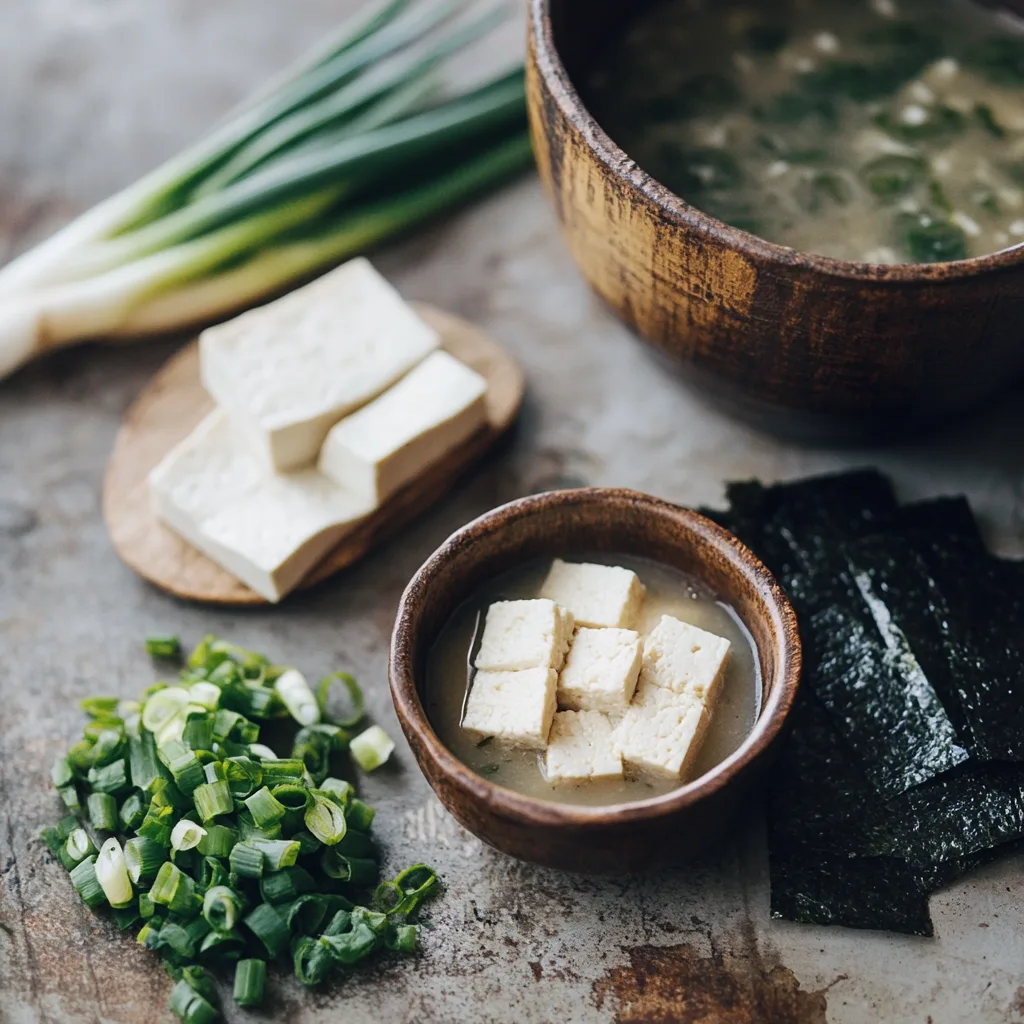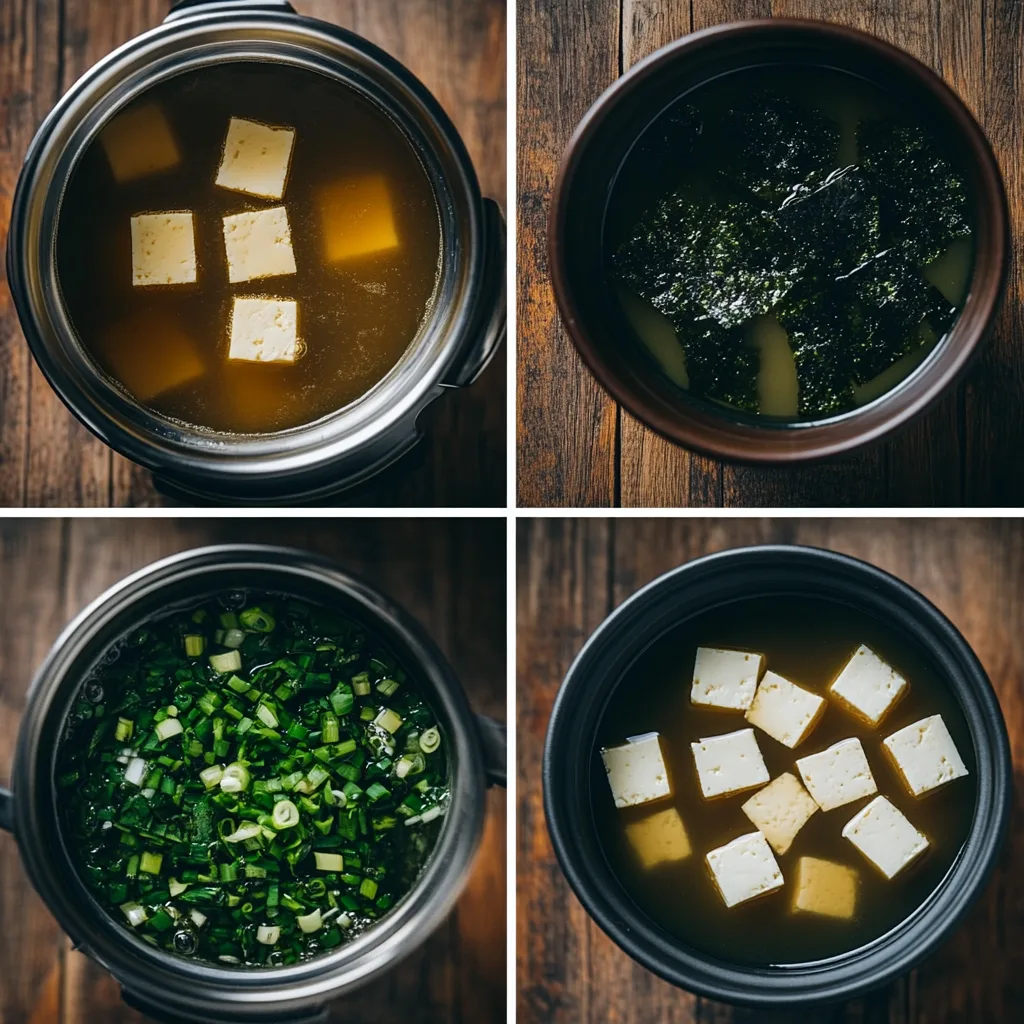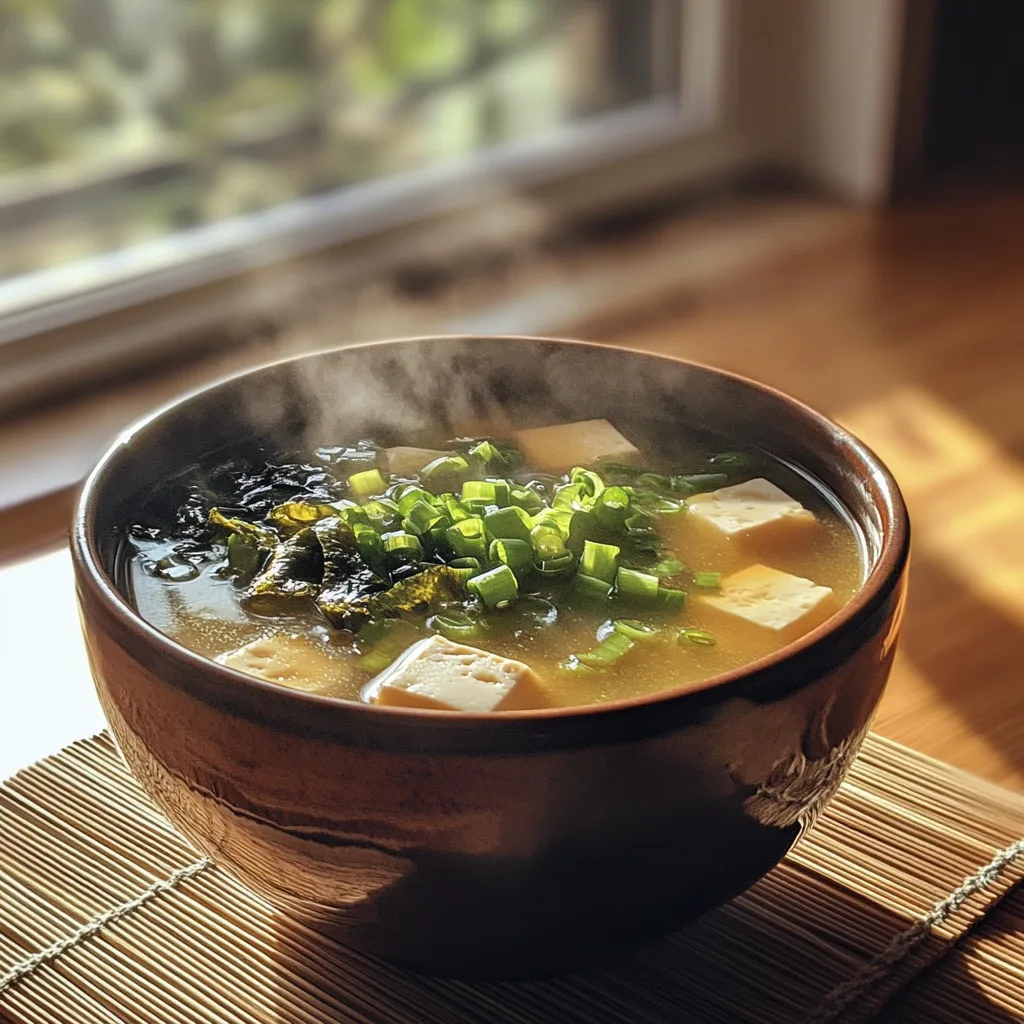Introduction
Miso soup, a staple in Japanese cuisine, isn’t just a warm and comforting dish—it’s also packed with nutrients and potential health benefits. But when it comes to miso soup carbs, many health-conscious eaters and keto dieters find themselves asking: How many carbs are actually in miso soup? Is it keto-friendly? Can it fit into a low-carb diet without guilt? These questions arise frequently as people aim to balance their love for flavorful dishes with their nutritional goals.
In this article, we’ll dive deep into everything you need to know about miso soup carbs. From breaking down its carb content to understanding the role of key ingredients like miso paste and tofu, we’ve got you covered. You’ll also learn about the health benefits, potential downsides, and even how to prepare a keto-friendly version at home. Ready to unravel the mysteries behind this delicious soup? Let’s start with Part 1: understanding the source of carbs in miso soup.
Understanding Carbs in Miso Soup
Miso soup may seem like a simple dish, but when it comes to its carb content, there’s more than meets the eye. Let’s break down where the carbs come from and how they fit into a balanced diet.
What Are Carbs in Miso Soup Made Of?
The carbs in miso soup primarily come from two sources: miso paste and any added ingredients like tofu, seaweed, or vegetables. Miso paste is made from fermented soybeans, rice, or barley—each contributing varying amounts of carbohydrates. While soybeans themselves are relatively low in carbs, rice or barley used in certain types of miso paste can add a bit more to the total count.
On average, a standard serving of miso soup contains about 7 grams of carbs per bowl. This number can vary depending on the recipe and additional ingredients used. For instance, instant miso soup packets may contain added sugars or starches, increasing their carb content.
Interestingly, the fermentation process of miso also plays a role. Fermentation helps break down some carbohydrates, making them easier to digest and absorb. This is one reason why miso soup is often considered a gut-friendly dish despite containing carbs.
How Miso Paste Contributes to Carb Content
Miso paste is the star of the show when it comes to miso soup carbs. This traditional Japanese ingredient is crafted through a long fermentation process involving soybeans, salt, and a fermenting agent called koji. Depending on the type of miso—white (shiro), red (aka), or mixed (awase)—the carb content will differ slightly.
- White Miso (Shiro Miso): Made with more rice and shorter fermentation, it has a slightly higher carb content.
- Red Miso (Aka Miso): Fermented for longer, red miso has a richer flavor and slightly lower carbs.
- Mixed Miso (Awase Miso): A balanced blend of white and red miso, offering a middle ground in both flavor and carb content.
On average, 1 tablespoon of miso paste contains around 3-4 grams of carbs. This might not seem like much, but when combined with other ingredients in the soup, it adds up.
For those following a low-carb or keto diet, it’s essential to be mindful of the type of miso paste used. Opting for a lighter soup base with minimal added ingredients can help keep carb counts in check.
In summary, while miso soup carbs may not be excessively high, they do require consideration, especially for strict low-carb dieters. The key lies in understanding the ingredients and making mindful choices.
Nutritional Breakdown of Miso Soup
| Nutrient | Amount per 100g |
|---|---|
| Calories | 56 kcal |
| Carbohydrates | 7 g |
| Protein | 3 g |
| Fat | 2 g |
| Sodium | 43% RDI |
| Vitamin K | 10% RDI |
| Manganese | 12% RDI |
| Copper | 6% RDI |
| Zinc | 5% RDI |
When it comes to understanding miso soup carbs, it’s essential to look beyond just carbohydrate content. A bowl of miso soup isn’t just about flavor—it’s also packed with essential nutrients. Let’s break down the nutritional profile of this popular Japanese dish.
Calories, Protein, and Carbs in a Serving of Miso Soup
A standard serving of miso soup typically contains around 56 calories, with 7 grams of carbs, 2 grams of fat, and 3 grams of protein. While the carb content in miso soup is relatively modest, its nutritional benefits go far beyond just the numbers.
Miso paste, the primary ingredient, is a powerhouse of vitamins and minerals, including manganese, copper, zinc, and vitamin K. These nutrients play a crucial role in supporting overall health, from boosting immunity to promoting healthy digestion.
One interesting fact about miso soup carbs is that they are mostly derived from natural sources like soybeans and rice used in miso paste. These complex carbs offer more sustained energy compared to simple sugars.
If you’re following a strict keto or low-carb diet, portion control is key. A single bowl is generally acceptable, but adding starchy vegetables or too much tofu can spike the carb count.
For more insights into balancing calories and carbs in soups, check out this creamy potato soup recipe.
How Ingredients Like Tofu, Seaweed, and Green Onions Affect Carbs
The secondary ingredients in miso soup, such as tofu, seaweed, and green onions, also influence the total miso soup carbs.
- Tofu: A protein-rich ingredient that adds minimal carbs to miso soup, making it a keto-friendly option.
- Seaweed: Naturally low in carbs but high in fiber and essential minerals like iodine.
- Green Onions: These add a burst of flavor and texture while contributing only a trace amount of carbs.
However, variations in recipes can impact carb content. For instance, adding noodles or root vegetables can significantly increase the carb count.
In conclusion, miso soup carbs are manageable in most diets, but ingredient choices and serving sizes matter. Keep it light and focus on whole, natural ingredients for the best balance.
Is Miso Soup Low-Carb and Keto-Friendly?

One of the most frequently asked questions about miso soup carbs is whether it’s suitable for a low-carb or keto diet. The answer depends on the recipe and portion size.
How Many Carbs Are in a Typical Bowl of Miso Soup?
A traditional bowl of miso soup contains around 7 grams of carbs, but this number isn’t set in stone. Pre-packaged miso soup or restaurant versions might have higher carb content due to added sugars, starches, or extra ingredients like root vegetables.
To keep your carb intake in check:
- Stick to homemade miso soup whenever possible.
- Choose miso paste with minimal added sugar or rice content.
- Avoid pre-packaged soups with high-carb flavor enhancers.
Is Miso Soup Suitable for a Keto Diet?
Yes, miso soup can be keto-friendly if prepared carefully. The key lies in controlling the quantity of miso paste and avoiding high-carb additives. Traditional miso soup recipes with tofu, green onions, and seaweed align well with low-carb guidelines.
For an ideal keto-friendly experience:
- Use red or mixed miso paste, as they typically have lower carb content.
- Add protein-rich ingredients like tofu or chicken to increase satiety.
If you’re looking for inspiration, check out this chicken miso soup recipe for a keto-friendly option.
Low-Carb Miso Soup Variations
Experimenting with your miso soup recipe can help tailor it to your diet. Here are a few low-carb tweaks:
- Replace tofu with extra seaweed or mushrooms.
- Use bone broth instead of traditional dashi stock for extra protein.
- Skip starchy veggies and stick to low-carb greens like spinach or bok choy.
In short, miso soup carbs are generally low enough to fit into most low-carb diets, especially when you’re mindful of the ingredients.
Health Benefits
Miso soup isn’t just a comforting bowl of warmth—it’s also brimming with health benefits. From aiding digestion to boosting immunity, this traditional Japanese soup offers a variety of wellness perks. Let’s explore how miso soup carbs and other nutrients contribute to overall health.
Probiotic Benefits for Digestion
One of the standout features of miso soup is its probiotic content. Thanks to the fermentation process involved in creating miso paste, this soup becomes a natural source of gut-friendly bacteria. These probiotics help:
- Improve digestion
- Strengthen gut health
- Enhance nutrient absorption
The probiotics in miso soup carbs also support the gut microbiome, which plays a crucial role in overall health. However, overheating the soup can destroy these probiotics. To maximize benefits, ensure the miso paste is added towards the end of cooking and avoid boiling it vigorously.
Nutritional Vitamins and Minerals in Miso Soup
Beyond miso soup carbs, this dish is a rich source of essential vitamins and minerals, including:
- Manganese: Supports metabolism and antioxidant function
- Vitamin K: Crucial for bone health and blood clotting
- Copper: Helps in energy production and iron absorption
- Zinc: Strengthens the immune system
The combination of these nutrients not only boosts immunity but also enhances energy levels. Plus, miso soup’s low-calorie count makes it an ideal choice for weight management.
For more insights on nutrient-rich soups, you might enjoy this lentil soup nutrition guide.
How Miso Soup Supports Brain and Heart Health
The benefits of miso soup go beyond the gut. Probiotics found in miso soup carbs have been linked to improved brain health, including better memory, reduced anxiety, and lower stress levels.
Additionally, certain compounds in miso paste may support heart health by:
- Reducing bad cholesterol (LDL)
- Regulating blood pressure
Incorporating miso soup into your regular diet can contribute to both mental clarity and cardiovascular wellness. However, moderation is key, as miso soup is also high in sodium.
In summary, the health benefits of miso soup make it a fantastic addition to any balanced diet. Whether you’re focused on gut health, brain function, or overall wellness, this traditional dish delivers.
Potential Downsides of Miso Soup
While miso soup carbs and its health benefits make it a favorable option for many, there are a few potential downsides to consider. Sodium content, thyroid concerns, and specific dietary restrictions might make miso soup unsuitable for some individuals.
High Sodium Content and Its Impact
One of the most significant drawbacks of miso soup is its high sodium content. A single serving can contain up to 43% of the Recommended Daily Intake (RDI) of sodium. High sodium levels can:
- Increase blood pressure
- Lead to water retention and bloating
- Pose risks for individuals with heart or kidney conditions
To reduce sodium intake while enjoying miso soup:
- Use low-sodium miso paste
- Limit portion sizes
- Pair it with low-sodium dishes
If you’re watching your sodium intake, balancing miso soup with fresh vegetables or low-sodium sides can help.
For another healthy, flavorful alternative, check out this chicken miso soup recipe.
Considerations for Individuals with Thyroid Disorders
Miso paste, made primarily from soybeans, contains goitrogens. These compounds can interfere with thyroid function, especially in individuals with hypothyroidism or other thyroid-related conditions.
While occasional consumption of miso soup is generally safe, individuals with thyroid concerns should:
- Limit their intake of miso soup
- Consult their healthcare provider before making it a regular part of their diet
Additionally, vitamin K content in miso can interact with blood-thinning medications. If you’re on such medication, be sure to monitor your intake.
Is Miso Soup Safe for Diabetics?
The carbs in miso soup are generally low and come from complex sources, making it a relatively safe option for diabetics. However:
- Instant miso soups may contain added sugars
- Overconsumption can still cause slight blood sugar spikes
To stay on the safe side, prepare homemade miso soup with fresh, whole ingredients and monitor your blood sugar levels after consumption.
In short, while miso soup carbs are manageable for most people, individuals with specific health conditions should exercise caution and consult with their healthcare providers before making it a dietary staple.
For more delicious and health-conscious recipes, explore other options on Recipe Popular.
How to Make Low-Carb Miso Soup at Home

Creating a delicious, low-carb miso soup at home is easier than you might think. By carefully selecting ingredients, you can enjoy a flavorful bowl while keeping miso soup carbs low and your diet on track. Let’s dive into the essential components and step-by-step preparation of this classic dish.
Essential Ingredients for a Low-Carb Miso Soup
To craft a keto-friendly and low-carb miso soup, it’s important to focus on fresh, high-quality ingredients. Here’s what you’ll need:
- Dashi Stock: The traditional base for miso soup, made from kombu (seaweed) and bonito flakes.
- Miso Paste: Opt for red miso paste (aka miso) or mixed miso paste (awase miso) for a deeper flavor with fewer carbs.
- Tofu: Adds protein without a significant increase in carbs.
- Seaweed (Nori or Wakame): Naturally low-carb and packed with minerals.
- Green Onions: For a fresh, zesty finish.
- Optional Additions: Mushrooms, spinach, or bok choy for extra nutrients.
When choosing your miso paste, always check the label for added sugars or starches, as these can increase miso soup carbs.
Step-by-Step Keto Miso Soup Recipe
Follow these simple steps to prepare your own low-carb miso soup:
- Prepare the Dashi Stock: In a pot, bring 4 cups of water to a gentle simmer. Add kombu and bonito flakes. Let it steep for about 5 minutes, then strain the stock.
- Add Vegetables and Tofu: Add tofu cubes, seaweed, and any chosen vegetables to the stock. Simmer for 2-3 minutes.
- Incorporate Miso Paste: In a small bowl, dissolve 2 tablespoons of miso paste in a bit of warm dashi stock. Stir until smooth, then gently add it back into the pot.
- Avoid Boiling: Keep the heat low to prevent the probiotics in miso paste from being destroyed.
- Finish with Green Onions: Add chopped green onions just before serving.
Serve your homemade miso soup immediately for the best taste and maximum health benefits.
This recipe ensures a satisfying, low-carb version of miso soup, perfect for those following keto or low-carb diets. Plus, making it at home gives you control over the ingredients and overall carb content.
FAQs
When it comes to miso soup carbs, people often have a lot of questions. In this section, we’ll address some of the most common ones to help clarify any confusion.
How Many Carbs Are in Miso Soup?
A typical bowl of miso soup contains about 7 grams of carbs. However, the exact amount can vary based on the type of miso paste used, additional ingredients, and whether it’s homemade or store-bought. Instant miso soups often contain higher carb counts due to added starches and flavor enhancers.
Does Miso Soup Have Carbs?
Yes, miso soup does contain carbs. Most of the carbs come from miso paste, which is made from fermented soybeans, rice, or barley. Additional ingredients like tofu, seaweed, and vegetables contribute minimally to the total carb count.
Is Miso Soup Low Carb?
Miso soup is generally considered low-carb when made traditionally with minimal added ingredients. However, pre-packaged or restaurant versions might contain hidden sugars or starches, so it’s always wise to check the ingredients.
Are There Carbs in Miso Soup?
Absolutely. The carbs primarily come from miso paste and vary depending on whether the miso is white, red, or mixed. On average, one tablespoon of miso paste contains about 3-4 grams of carbs.
Is Miso Soup Good for Weight Loss?
Yes! Miso soup is low in calories and packed with nutrients, making it an excellent choice for weight loss. The carbs in miso soup are complex and provide sustained energy without causing spikes in blood sugar.
For those following specific diets like keto or low-carb plans, homemade miso soup is the safest option to ensure full control over miso soup carbs and overall nutrition.
Common Misconceptions About Miso Soup Carbs
Miso soup is often praised for its health benefits, but some misconceptions about miso soup carbs and its nutritional profile still linger. Let’s debunk a few of the most common myths.
Does Boiling Miso Soup Destroy Probiotics?
One of the biggest misconceptions about miso soup is that boiling it destroys all its probiotics. While it’s true that excessive heat can kill beneficial bacteria, it doesn’t mean your soup becomes completely void of nutritional benefits.
When adding miso paste to your soup:
- Avoid boiling the soup after adding the paste.
- Stir the paste in gently over low heat.
- Aim for a simmer, not a rolling boil.
Even if some probiotics are lost, miso soup still delivers plenty of vitamins, minerals, and amino acids that support overall health.
Is All Miso Soup Vegan?
Another common myth is that all miso soup is vegan. While the miso paste itself is usually vegan-friendly, the dashi broth traditionally used in miso soup often contains bonito flakes (fish-based).
If you’re looking for a vegan option:
- Use kombu dashi made from seaweed instead of bonito flakes.
- Double-check ingredient lists in store-bought or restaurant-made soups.
For a truly plant-based miso soup, homemade is often the safest route.
These misconceptions highlight the importance of understanding the ingredients and preparation methods behind this beloved soup. By being informed, you can fully enjoy the benefits without falling for common myths.
Final Thoughts
Miso soup is more than just a warm, comforting dish—it’s a nutritional powerhouse with a unique balance of flavor and health benefits. Whether you’re watching your carb intake, following a keto diet, or simply aiming for a healthier meal plan, miso soup carbs can fit into your routine with a little attention to detail.
Balancing Miso Soup in a Low-Carb Diet
When enjoying miso soup as part of a low-carb or keto-friendly diet:
- Keep an eye on portion sizes.
- Choose high-quality miso paste with minimal added sugars.
- Pair it with protein-rich sides like sashimi or grilled chicken.
Miso soup works best as part of a balanced meal, providing essential nutrients without overloading on carbs.
Key Takeaways for Miso Soup Enthusiasts
To wrap things up, here are the key points to remember about miso soup carbs:
- A typical serving contains around 7 grams of carbs.
- The primary source of carbs is miso paste.
- Homemade versions are the best way to control carb content and ingredients.
- Avoid boiling miso paste to preserve probiotics.
Miso soup is a versatile, nutrient-dense dish that can be enjoyed in countless ways. Whether you’re sipping it as a starter or pairing it with a low-carb main course, it’s a fantastic addition to any diet.
Incorporating miso soup carbs into your meal planning can provide both flavor and health benefits, making every spoonful worth savoring.



